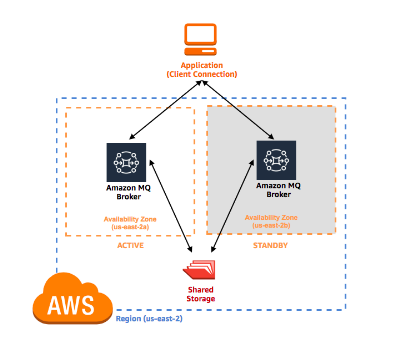Last updated on July 25, 2023
Amazon MQ Cheat Sheet
- AWS offering for a managed message broker service for Apache ActiveMQ. Message brokers allow different software systems–often using different programming languages, and on different platforms–to communicate and exchange information.
- Amazon MQ also supports RabbitMQ, a popular open-source message broker. Migrate your existing RabbitMQ message brokers to AWS without having to rewrite code.
Features
-
- Amazon MQ uses industry-standard APIs and protocols for messaging, including Java Message Service (JMS), .NET Message Service (NMS), AMQP, STOMP, MQTT, OpenWire, and WebSocket.
- Amazon MQ manages administrative tasks such as hardware provisioning, broker setup, software upgrades, and failure detection and recovery.
- Amazon MQ stores your messages redundantly across multiple Availability Zones (AZs).
- Amazon MQ supports both single-instance brokers, suitable for evaluation and testing, and active/standby brokers for high availability in production. In the event of a failure of the broker, or even a full AZ outage, Amazon MQ automatically fails over to the standby broker.
- ActiveMQ messaging features
- ActiveMQ provides all the standard JMS features including:
- point-to-point (message queues),
- publish-subscribe (topics),
- request/reply,
- persistent and non-persistent modes,
- JMS transactions,
- and distributed (XA) transactions.
- ActiveMQ also supports more complex patterns such as:
- composite destinations (producers can send the same message to multiple destinations)
- virtual destinations (publishers broadcast messages via a topic to a pool of receivers subscribing through queues)
- ActiveMQ preserves the order of messages sent by a single producer to all consumers on a topic.
- ActiveMQ supports message groups, which enable multiple consumers on a queue to process messages within a group in first-in, first-out (FIFO) order.
- ActiveMQ also supports message redelivery and dead letter queues when a message cannot be delivered to its destination.
- ActiveMQ provides all the standard JMS features including:
Amazon MQ Brokers
-
- A message broker environment running on Amazon MQ. It is the basic building block of Amazon MQ.
- Brokers created without public accessibility can’t be accessed from outside of your VPC.
- Broker Types
- A Single-instance broker is comprised of one broker in one Availability Zone. The broker communicates with your application and with an AWS storage location.
- A Single-instance broker is comprised of one broker in one Availability Zone. The broker communicates with your application and with an AWS storage location.
-
-
- An Active/standby broker for high availability is comprised of two brokers in two different Availability Zones, configured in a redundant pair. These brokers communicate synchronously with your application, and with a shared storage location.
-
-
- Broker instance types
- Mq.t2.micro
- mq.t2.micro instances are designed for initial product evaluation
- Mq.m4.large
- Mq.m5.large
- mq.m5.large instance for default production usage
- Mq.m5.xlarge
- Mq.m5.2xlarge
- Mq.m5.4xlarge
- Mq.t2.micro
- A network of brokers is comprised of multiple simultaneously active single-instance brokers or active/standby brokers. You can configure networks of brokers in a variety of topologies (for example, concentrator, hub-and-spokes, tree, or mesh).
- Broker instance types
Configuration
-
- A configuration contains all of the settings for your ActiveMQ broker, in XML format.
- Making changes to a configuration does NOT apply the changes to the broker immediately. To apply your changes, you must wait for the next maintenance window or reboot the broker.
Security and Monitoring
-
- Amazon MQ provides encryption of your messages at rest and in transit.
- Connections to the broker use SSL, and access can be restricted to a private endpoint within your Amazon VPC.
- Authentication from applications to the ActiveMQ broker itself is provided using username and password-based authentication.
- Amazon MQ supports LDAP authentication and authorization with directory services like Microsoft Active Directory.
- Amazon MQ is HIPAA eligible and meets standards for PCI, SOC, and ISO compliance.
- You can configure Amazon MQ to publish general and audit logs to Amazon CloudWatch Logs.
Amazon MQ Pricing
-
- You pay for the time your message broker instance runs (price varies depending on the size of the instance used), the storage you use monthly, and standard data transfer fees.
-
IBM MQ
- IBM MQ is messaging middleware that simplifies and accelerates the integration of diverse applications and business data across multiple platforms.
- It uses message queues to facilitate the exchange of information.
- Features
-
-
- It offers a single messaging solution for cloud, mobile, IoT, and on-premises environments.
- The IBM MQ service on AWS supports client messaging applications from
- within your virtual private cloud (VPC),
- from trusted addresses on the internet,
- and via a VPN from your on-premises environment.
- Secure message delivery with end-to-end encryption.
- Dynamic scaling via auto scaling groups since IBM MQ runs on an EC2 instance running on a pre-built AMI.
- The IBM MQ server is typically placed in a private subnet, spanning across two availability zones for high availability. The only ways to access it are through two ports exposed by a public facing elastic load balancer (ELB) or, if you need to SSH to the host, via a Bastion server from the public subnet.
- All the queue manager data is stored on Amazon EFS.
-
Amazon MQ Cheat Sheet References:
https://aws.amazon.com/amazon-mq/features/
https://docs.aws.amazon.com/amazon-mq/latest/developer-guide/welcome.html
https://aws.amazon.com/amazon-mq/pricing/
https://aws.amazon.com/amazon-mq/faqs/
https://aws.amazon.com/quickstart/architecture/ibm-mq/
https://aws-quickstart.s3.amazonaws.com/quickstart-ibm-mq/doc/ibm-mq-on-the-aws-cloud.pdf




















